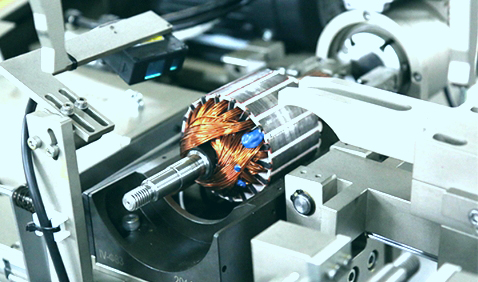What are the common mechanical failures and solutions for motor motor rotor automatic balancing machine?
First, the transmission system failure
1、Belt transmission problems
Failure phenomenon: belt slippage, severe wear or breakage. Belt slippage will lead to unstable rotor speed, affecting the accuracy of the balance test; belt wear will reduce transmission efficiency, and may produce abnormal vibration and noise; belt breakage will directly lead to the equipment can not operate normally.
Solution: If the belt slips, you can first check the tension of the belt and increase the tension of the belt by adjusting the tensioning wheel. For the worn belt, it needs to be replaced in time, and when choosing a new belt, make sure that its model and specifications are in line with the requirements of the equipment. At the same time, check whether the pulley is worn or deformed, and if there is any problem, it should also be replaced or repaired.

2、Coupling failure
Failure phenomenon: coupling loose, wear or damage. Loose coupling will make the connection between the rotor and drive shaft unstable, resulting in vibration and displacement; worn coupling will affect the accuracy and smoothness of power transmission; damaged coupling will result in the power can not be effectively transmitted.
Solution: For loose couplings, check and tighten the connecting bolts. If the coupling is worn, the degree of wear needs to be assessed. Mild wear can be repaired by adjusting the gap, etc., while severe wear requires replacement of the coupling. At the same time, attention should be paid to check the coaxiality of the shafts at both ends of the coupling to ensure that it maintains good alignment during installation and use.
Second, the rotor support system failure
1、Bearing failure
Failure phenomenon: bearing heat, abnormal sound or wear. Bearing heat may be due to poor lubrication, overload or improper installation; abnormal sound may be bearing internal component damage, ball and raceway between the foreign body or clearance is too large; bearing wear will make the rotor rotary precision decline, affecting the balance effect.
Solution: If the bearings are hot, first check the lubrication and supplement or replace with suitable grease. For overload problem, analyze the load condition of the rotor and adjust the working parameters of the balancing machine reasonably. If abnormal sound is heard, it is necessary to dismantle the bearings for checking, clearing out the foreign matter or replacing the damaged bearings. When installing new bearings, it is necessary to operate in accordance with the correct method to ensure the installation accuracy.
2、Wear of shaft journal
Failure phenomenon: wear, scratches or corrosion on the surface of the journal. This can lead to a reduction in the rotational accuracy of the rotor in the support system, increase the amount of unevenness, and may cause vibration.
Solution: For minor wear and scratches, surface repair methods such as grinding and polishing can be used. If the wear is severe, it may be necessary to replace the journal section or the entire rotor. At the same time, it is necessary to analyze the causes of wear, such as poor lubrication, corrosion caused by poor sealing, etc., and take appropriate measures to prevent it.
Third, the mechanical structure of the loose or deformation failure
1, loose body parts
Failure phenomenon: the balancing machine shell, bracket or other structural components of the connecting bolts loose, resulting in vibration and noise during operation of the equipment, affecting the stability of the balance test.
Solution: Regularly check the connecting bolts of the equipment and tighten the loose bolts with suitable tools. For frequent loosening of the bolts, you can consider adopting anti-loosening measures, such as the addition of spring washers, the use of thread locking agent and so on.
2、Structural deformation
Failure phenomenon: Due to long-term force, collision or unreasonable installation and other reasons, the body structure of the balancing machine deformation. This will affect the accuracy of the rotor installation and the accuracy of the axis of rotation, which will lead to inaccurate balancing test results.
Solution: For minor deformations, they can be repaired through adjustment and calibration. If the deformation is serious, it may be necessary to replace the deformed parts or re-install and debug the whole equipment. In the daily use and maintenance of equipment, to avoid collision and unreasonable external forces to ensure the structural integrity of the equipment.
Fourth, the protection device failure
1, the guardrail and shield problems
Failure phenomenon: guardrail deformation, damage or cover loose, fall off. Problems with the guards will expose the operator to a dangerous environment, increasing the risk.
Solution: For deformed and damaged guardrails, repair or replace them in time. Check the fixing of the guards to ensure that they are firmly installed on the equipment. At the same time, operators should be educated on the correct use and maintenance of guards to avoid the failure of guards due to human factors.
※ If you still can not solve the equipment failure through the above ways and means, please contact the technical specialist of Xinhui Electromechanical Equipment Company Limited through the page chat tool to seek help.







